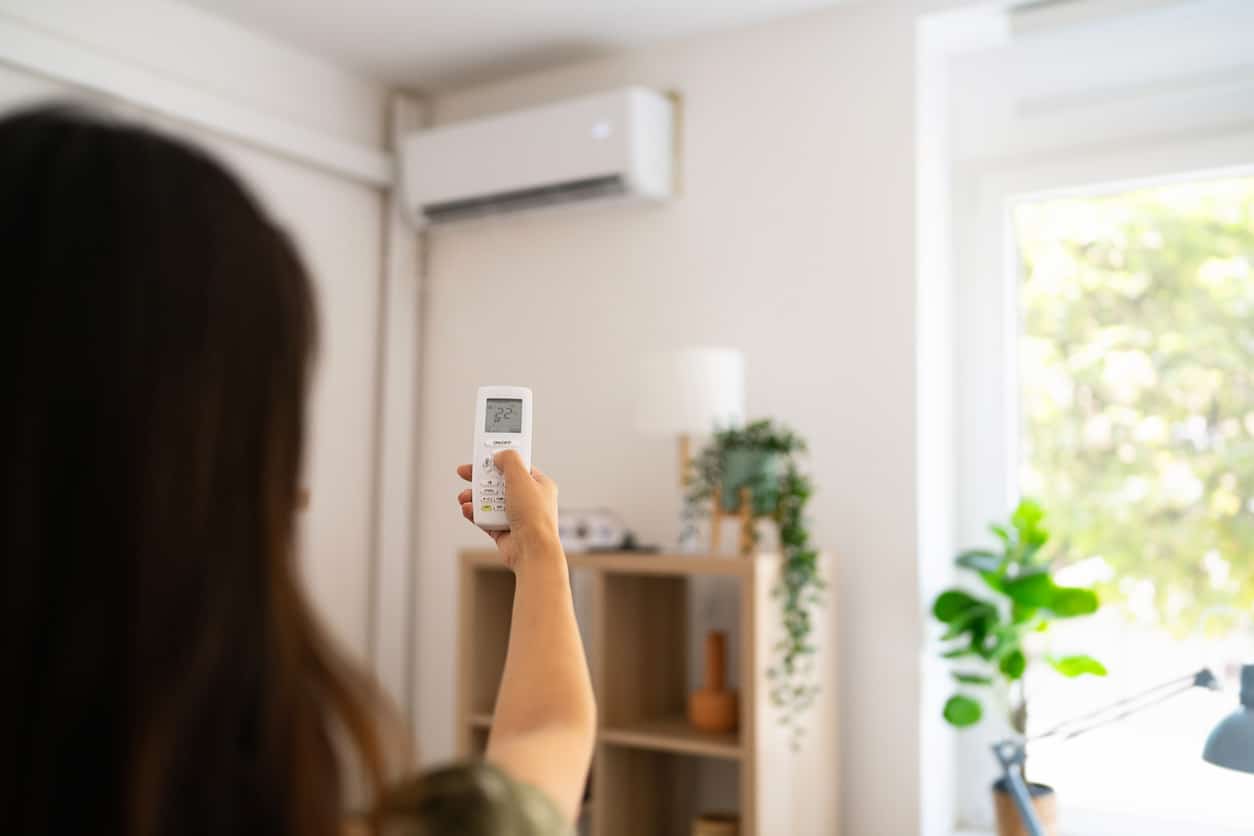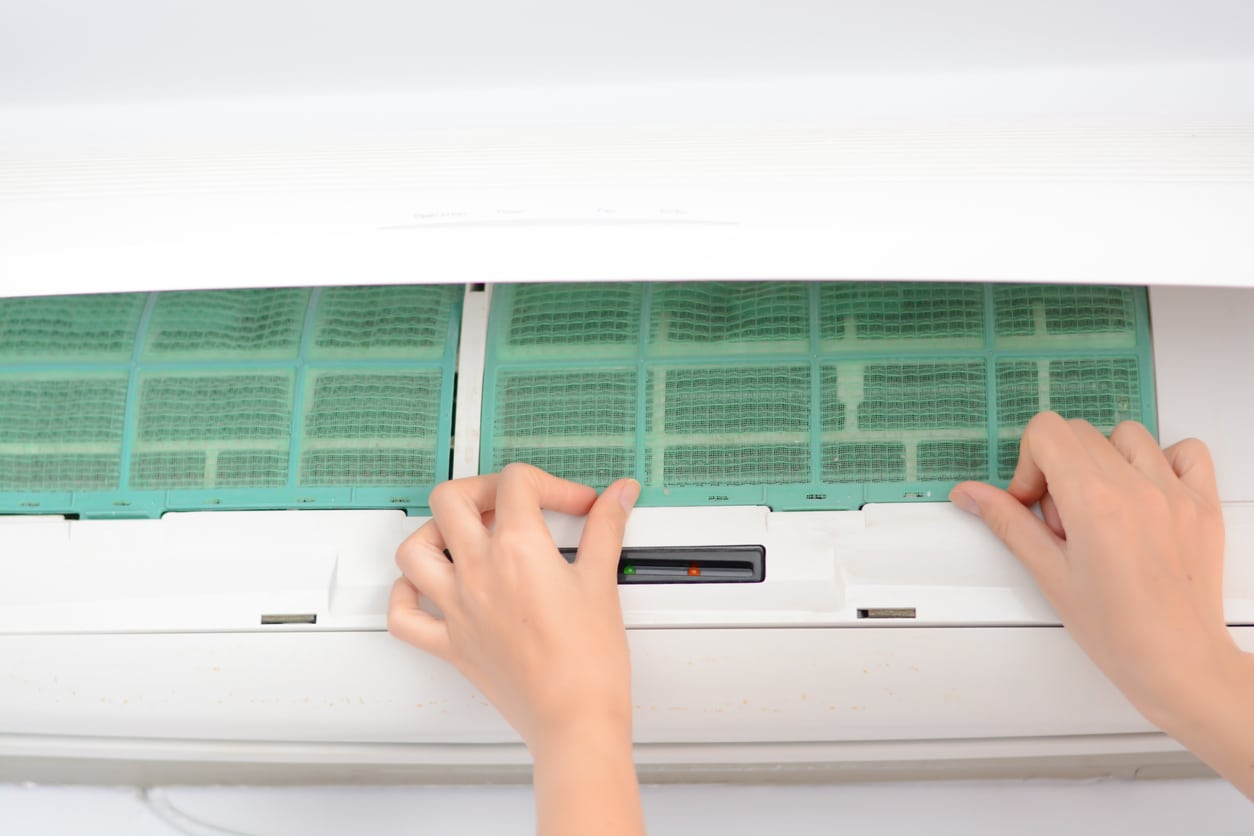Mini-split ACs have gained a lot of notoriety as of late, mainly because they’re energy-efficient and work beautifully without the help of air ducts. We’ll look at when mini-split AC installation is a good choice, how the installation process works, and what kind of maintenance you can expect once it’s up and running.
Table of Contents
- What is a Mini Split?
- Types of Mini Split Systems
- Pros & Cons of Mini Split Systems
- Mini Splits vs Other HVAC Options
- Is a Mini Split Right for Your Space?
- Mini Split System Install & Maintenance
- Mini Split System Rebates & Tax Credits
- Frequently Asked Questions About Mini Split Systems
What Is a Mini-Split AC?
When considering an air conditioner, you probably think of central air or wall units first. However, mini-split ACs are becoming increasingly popular, primarily because they are remarkably efficient and don’t require ductwork. New homes and renovations may opt for mini-splits to protect the environment and lower costs for property owners.

Mini-splits get their name from the units used to create the system. With one outdoor unit and usually several indoor units, indoor and outdoor units connect through a thin channel. The indoor unit cools the air, meaning you don’t need a duct system to carry treated air to the rest of the home. The outdoor units look much like the standard outdoor AC compressors you’re likely used to, and the indoor units are placed strategically around the house. Plus, some mini-splits are capable of heating the home as well as cooling it.[1]
One of the biggest perks about these additional indoor units around the home is the ability to program them based on your desired temperature. Instead of cooling whole areas of the home that you may not enter as often, you get room-by-room control. While zoned heating and cooling is more efficient than traditional heating and cooling, it can’t match the accuracy of a mini-split AC.[2]
Types of Mini Split Systems
There are a few types of mini-split systems on the market today:
- Single-zone: Usually meant for one room, a single-zone mini-split is just one outdoor and one indoor unit.
- Multi-zone: Multi-zones will use up to four indoor units per condenser. Multi-zone mini-splits are an excellent choice for anyone who wants to split the temperature into separate rooms.
- Ceiling cassette: This mini-split distributes air from the top, distributing a broader airflow.
- Mounted mini-split: Mini-splits can be mounted on the wall or floor, depending on the height of the windows and ceilings.
- Concealed: It’s possible to hide a mini-split AC by connecting it to one of your ducts.
Mini-splits run on electricity, as opposed to propane or natural gas. Smaller mini-splits require a 110-volt outlet, while larger units (above 12k BTU) need 220-volt. The most significant consideration is whether you have a dedicated circuit for the mini-split. These appliances are energy efficient but require enough power to run.
Pros & Cons of Mini Split Systems

Mini-split systems have several advantages, but as with other appliances, they come with some drawbacks too:
- Lower utility bills: Thanks to zone control cooling and higher SEER ratings, you can expect your energy bills to decrease if you choose a mini-split. The amount of money you’ll save on utility bills depends on your location, energy use, and the size of the system.
- Convenient: Homes that are adding space but don’t want to install new ducts can use single-zone mini-splits to solve the problem.
- Easy installation and maintenance: Mini-split systems are ductless, which makes them easier to install and maintain. This can save you money on repair work throughout its lifespan.
- Quiet: For anyone sensitive to sounds, whether a spouse or a newborn, quiet operation can greatly benefit residents. Both indoor and outdoor units operate quietly.
- Versatile: You can purchase mini-split models that heat and cool your home, eliminating the need for two different systems.
The major disadvantage of the mini-split air conditioner is that it has a higher installation cost. However, for most homeowners, the convenience and energy efficiency of mini-split systems make them well worth the heightened price tag.
Mini Splits vs Other HVAC Options
Choosing between a mini-split and standard HVAC appliances depends on more than a price tag. From maintenance to resale value, we’ll review what to consider before you decide.Mini Splits vs. Central AC
If you want your home cooled at the same temperature in every room, central AC may be your better option. In addition, the central AC units are hidden, and the systems usually have a lower price tag and better air filtration. Remember that mini-splits are still more efficient, and most function as a furnace and AC.
Mini-Splits vs. Window or Portable Units
A standard window or portable unit usually has a low upfront cost, making it more attractive if you want to heat a few rooms. However, window units also tend to hog all the power, which is not always good for the environment or your utility bill. A mini-split would be a better option if you live in an area with a particularly touchy power grid.
Ducted Heat Pumps vs. Ductless Mini Splits
A ducted heat pump can cool the entire home, making it better for open-floor plans.[3] It’s also cheaper and can provide better air filtration, much like central air. Of course, if you don’t have ducts, then a ductless mini-split may be a lower cost in installation and a better energy saver overall. Depending on the model you purchase, the mini-split can act as a heat pump by heating and cooling your home.
PTAC vs. Mini-Splits
Packaged Terminal Air Conditioners (PTAC) are more likely to be seen in commercial buildings, though homeowners may choose them too. Installed through the walls, they are less expensive to install than mini-splits. However, they tend to cost more to operate and can be noisy and bulky in a home.
Is a Mini Split Right for Your Space?

Mini-splits are popular in both new and old homes alike. Because they’re so efficient, an AC mini split is good for homeowners who want to reduce their energy bills. They are more efficient to run as-is and can be programmed to heat and cool the precise space you need.
In older homes without ductwork, mini-splits are often the best option because they help homeowners avoid expensive ductwork installation. If you need future modifications, mini-splits are also easier to upgrade than the other appliances on the market.
Consider how a mini-split will cool your home and what it can do for your home’s resale value. As environmental concerns grow, more homeowners value energy-efficient homes that can ultimately bring down their monthly utility bills.
Mini Split System Install & Maintenance
Installation and maintenance concerns for a mini-split system will vary depending on the individual space and homeowner. We’ll look at a few key things to keep in mind.
Is DIY Mini-Split Install and Maintenance Safe?
Installing a mini-split system on your own can seem like an easy way to save money. Still, it comes with significant safety risks if proper precautions are not taken. Faulty wiring or not following code requirements could lead to gas leaks, electric shocks, fires, or even explosion hazards down the line.
That said, once installed correctly and safely by a certified HVAC technician, some basic maintenance tasks can safely be performed by homeowners. Simple filter changes, cleaning the filters and outdoor units, and visually inspecting the lines for damage or leaks are generally safe for homeowners to perform.
More complex repairs like recharging refrigerant, troubleshooting electrical issues, or any major repairs should always be left to the professionals. As long as you understand your DIY limits regarding the specialized skills required for mini-split servicing, some basic preventative maintenance is reasonable for responsible homeowners to take on.
Should I Have a Professional Install and Maintain My Mini-Split?
It is generally recommended to have such complex appliances installed by a qualified professional. If you make a mistake while installing your mini-split, you may void the unit’s warranty. Additionally, you could be putting your safety and the safety of your property at risk. A professional will know how the ductless mini split works, so you can be confident you’re getting the most energy-efficient system.
When it comes to general maintenance, the demands on the homeowner are relatively reasonable. Much like a standard AC, you’ll need to change the filter regularly and monitor the system’s performance. If you want to keep it operating at peak levels, servicing it once every six months can help you reap the most from your investment.
Mini Split System Rebates & Tax Credits
You may be eligible for rebates and tax credits when you install a mini-split air conditioner. For instance, the Inflation Reduction Act of 2022 promised a 30% cost reduction for homeowners who made energy-efficient improvements. There may also be state and local rebates available in addition to any rebates or incentives that the manufacturer offers.
What you receive depends on where your home is, which system you choose, and whether the individual program is still available. In some cases, there’s a limit for rebates, and the program ends when the funding runs out. There are usually caps on how much the program will provide and often income restrictions based on the financial need of the homeowner.
Mini Split FAQs
The general rule is to multiply the square footage of your space by 25 to get the total number of BTUs needed to cool the space. It’s essential to get the right mini-split size – a system that is too big or too small can cause issues with the efficiency of your system and cause unnecessary energy expenditure.
Mini-splits connect an indoor and outdoor unit to heat and cool a single space. You can get a single unit for an addition to your home or multiple units to cool the whole home.
It depends on the unit you purchase. Most mini-splits are set up to both heat and cool the home, unless you specifically purchase a cooling-only unit.
It depends on the size of the mini split AC unit, the installation method you choose, and the location of your home. Certain installations, such as ceiling-mounted ones, may be more complex, ultimately increasing the price.
For many people, the efficiency of mini-splits makes them worth their higher price tag. If you want the ability to control the temperature in every room so you’re not wasting a single penny, a mini-split may be worth it.
Not always – there are mini-split heat pumps that can both heat and cool the home. To learn more about which is right for you, contact our team and talk to a professional installer about your heating and cooling goals.



